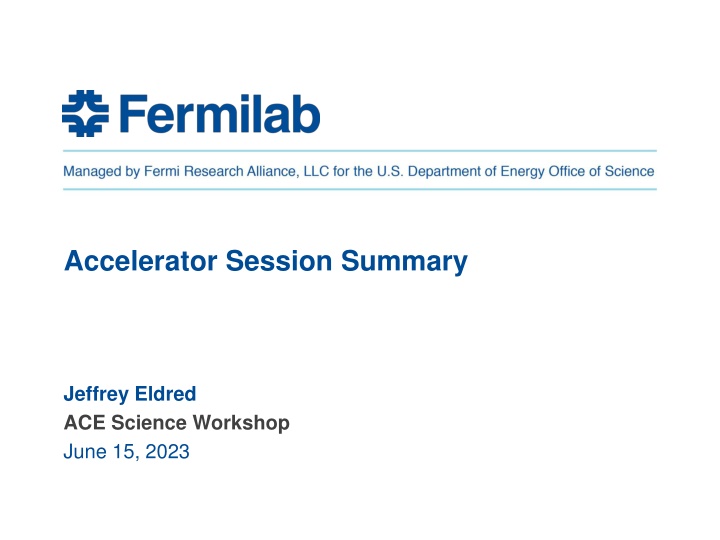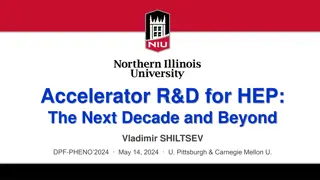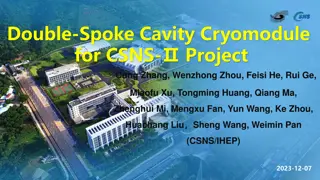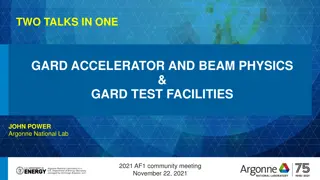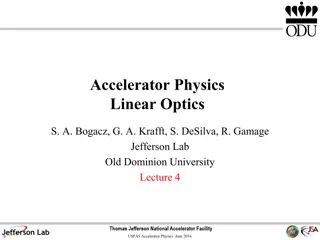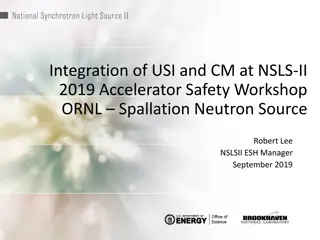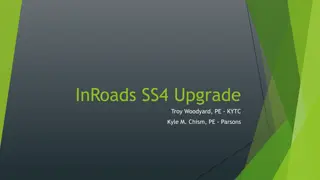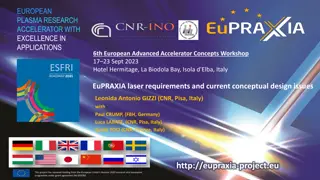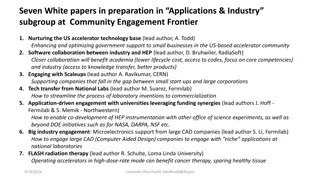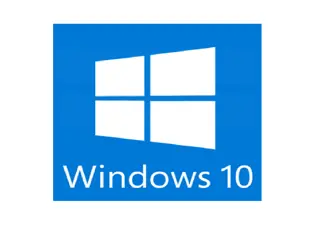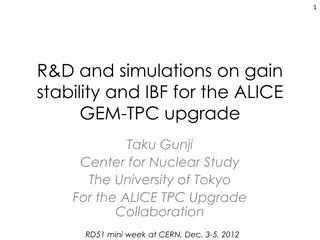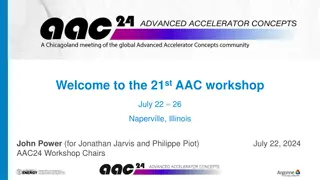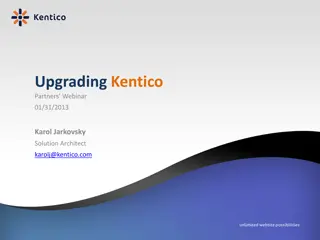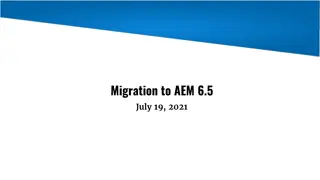Accelerator Upgrade Workshop Summary
Comprehensive analysis of the recent ACE Science Workshop discussions on accelerator upgrades for the LBNF program, including key points on both ACE RCS and ACE Linac approaches, muon collider considerations, high-power targetry R&D needs, technical/performance risks, and proposed next steps for system development.
Download Presentation

Please find below an Image/Link to download the presentation.
The content on the website is provided AS IS for your information and personal use only. It may not be sold, licensed, or shared on other websites without obtaining consent from the author.If you encounter any issues during the download, it is possible that the publisher has removed the file from their server.
You are allowed to download the files provided on this website for personal or commercial use, subject to the condition that they are used lawfully. All files are the property of their respective owners.
The content on the website is provided AS IS for your information and personal use only. It may not be sold, licensed, or shared on other websites without obtaining consent from the author.
E N D
Presentation Transcript
Accelerator Session Summary Jeffrey Eldred ACE Science Workshop June 15, 2023
2 High-Level Summary, Programs LBNF: Both ACE RCS and ACE Linac approaches are both technically sound and reasonably costed solutions. Power, reliability, flexibility. - Both start with a 2 GeV Linac New Physics: Spigots presented yesterday, Both scenarios extend linac to 2 GeV and increase beam power at 8 GeV, but some variation in the relative beam powers available for each spigot. Muon Collider: Neither ACE RCS not ACE Linac can be directly used as an 2-3 MW MuC proton driver. Should be re-optimized. - ACE RCS should be modified to be 100-200e12, 5-10 Hz. This requires serious consideration of space-charge issues. - Possibility of 2-8 GeV 10 Hz RCS upgrade to 3-12 GeV 5Hz RCS? - ACE Linac should be as high current as possible at 10 Hz. - 5mA x 2ms x 10Hz configuration upgrade to 20mA x 2ms x 10Hz. - ACE Linac a more natural fit for MuC than ACE RCS. 2 11/23/2024 Jeffrey Eldred |Snowmass 2.4 MW Upgrade with RCS
3 High-Level Summary, R&D Needs ***** High-Power Targetry R&D We need to develop 2+ MW DUNE/LBNF target as soon as possible. All our ambitious muon programs require novel/advanced targets. *** H- Laser Stripping H- Foil injection is the most challenging part of both ACE RCS/Linac - For 8-GeV H- stripping, no direct precedent. ** Muon Collider Target Demonstrator, Cooling Demonstrator Planning to use 0.8 GeV, 2 GeV Linac beam and/or 8 GeV Booster beam. ** GeV-Scale Accumulator Ring Design Real opportunity for 0.8 GeV compact AR with short pulses - Start with 100-300 kW at 0.8 GeV suitable for PIP2-BD - Updated to 1+ MW at ~2 GeV great for AMF/PIP2-BD * Metallized Ceramic Beampipe For 20 Hz RCS configurations, benefit from developing a prototype. * High-Gradient, High-Q SRF Linac Continuous improvement in cost/benefit SRF technology. 3 11/23/2024 Jeffrey Eldred |Snowmass 2.4 MW Upgrade with RCS
4 4 Final Slides Three Questions about Accelerator Upgrades 4 11/23/2024 Jeffrey Eldred |Snowmass 2.4 MW Upgrade with RCS
Jeff Eldred ACE 2-Gev Linac + 8-GeV RCS Design 1.How will your system/development address the BR goals of DUNE/LBNF, New Physics, MuC? DUNE/LBNF: 10Hz RCS may be the lowest cost, lowest risk configuration. New Physics: Spigots yesterday, CW up to 2 GeV MuC: There s a viable path, but advantage goes to Linac option. RCS gets more interesting with higher energies. 2. What are the biggest technical/performance risks of your system/development? H- Foil Injection, Laser stripping R&D. Looks okay, but biggest risk/limit. Ceramic/Dielectric Beampipe. Barrier to 20+ Hz ramp rate. MuC R&D, proton compression, HTS, muon production, cooling. 3. What are the most sensible first steps to enable progress in your system/ development? What can be done before the next ACE event (Fall 23 workshop)? Start prototype RCS ceramic beampipes. Develop decision tree/timeline for choosing RCS vs Linac upgrade. Resolve MuC R&D plan, role for Fermilab proton complex. 5 11/23/2024 Jeffrey Eldred |Snowmass 2.4 MW Upgrade with RCS
Sergey B ACE 8-GeV Linac + 8-GeV AR Design 1.How will your system/development address the BR goals of DUNE/LBNF, New Physics, MuC? All 3 BRL options deliver 2.4 MW to LBNF/DUNE and have extra beam for other experiments. The linac can be designed with additional spigots at intermediate energies if desired. Option C would have 1.2 MW power at 8 GeV available, which is close to what MuColl R&D would need. 2. What are the biggest technical/performance risks of your system/development? Develop a robust injection scheme? 3. What are the most sensible first steps to enable progress in your system/ development? What can be done before the next ACE event (Fall 23 workshop)? R&D on: high-gradient SRF cryomodule, laser-assisted injection, modeling the complete linac design, simulation and optimization of the injection painting and foil heating. Fall 23 is too soon to accomplish anything, but we can initiate some R&D topics and perhaps have preliminary results. 6 11/23/2024 Jeffrey Eldred |Snowmass 2.4 MW Upgrade with RCS
B. Pellico PAR AR for Booster Design 1.How will your system/development address the BR goals of DUNE/LBNF, New Physics, MuC? a) help LBNF/DUNE Phase II and improve reliability of the accelerator complex; To achieve Phase II you have to be successful in phase one! Success requires operating the Booster for the initial power ramp up during the critical commissioning and at least 5 years of running at required power. PAR is capable of helping the Booster deliver the necessary beam by reducing losses in the Booster and significantly reducing the complexity of the Booster operations. Taking the Booster Injection out of the Booster has several benefits that can t be underestimated: More space for a robust beam dump will be a HRA in Booster! Single turn injection into a rapid cycling Booster still uncertain how to do this without PAR Simplify the Booster RF locking to PIP-II Does not require Booster correctors to flatten orbit removing risks associated with pushing correctors Simple acceleration process in the Booster no longer need to transition from flat to ramping GMPS b) enable new physics spigots (RPF, etc); The only way to achieve a DS or any other beam based new physics program within a decade is PAR! Every other plan is 20 years away unless you leave Fermilab (the nations' HEP lab) c) layout foundation for the future MuColl R&D and facility If an accumulation ring is required for MuColl this will be a testing ground. We have not built an accumulator ring in decades PARs unique design and potential training is important to helping us ensure success at the next stage. 7 11/23/2024 Jeffrey Eldred |Snowmass 2.4 MW Upgrade with RCS
B. Pellico PAR AR for Booster Design 1. What are the biggest technical/performance risks of your system/development? I see no significant technical risks, but I do see timing challenges given approval how quickly can you manufacture required magnet systems fully tested. Placement ands design of service building requires site planning outside the PAR immediate group and may delay deployment of PAR. Performance risk Should be thought of as Flux limit(s) . Pulse systems 60to 80 Hz been shown how much is 100 Hz going to stress design Beam extraction loss, Beam Injection Loss 2. What are the most sensible first steps to enable progress in your system/ development? What can be done before the next ACE event (Fall 23 workshop)? The PAR beam dump needs to be designed (Could be done by fall) Actual mechanical stands and supports It would take two years to complete ME designs and drawings Civil work on building, penetrations, and cable runs all to be done 8 11/23/2024 Jeffrey Eldred |Snowmass 2.4 MW Upgrade with RCS
Katsuya Yonehara Muon Collider R&D Experiments: How does the experiment make use of the ACE beam? Muon collider demo facility Is the experiment uniquely enabled by The ACE upgrades? Yes Can this experiments be performed elsewhere? ACE BR is needed to demonstrate muon collider system which is the last stage to construct real muon colliders What particular accelerator components or capabilities are necessary? o What proton energies are needed? 5-15 GeV o What proton quantities are needed? > 1012 protons per bunch o What time structure is needed? (bunch length, train structure) Bunch length something in the ns scale, Repetition rate is not so important for the demo facility o Can the demonstrator be performed with 800 MeV protons from PIP-II or 8 GeV protons from the Booster with PIP-II? Yes for 8 GeV, No for 800 MeV 9 11/23/2024 Jeffrey Eldred |Snowmass 2.4 MW Upgrade with RCS
Katsuya Yonehara Muon Collider R&D How might an eventual Muon Collider benefit from ACE? What particular accelerator components or capabilities are necessary for the experiment? What proton energies are needed? 5-15 GeV approximately What proton quantities are needed? 10^14 approximately What time structure is needed? (bunch length, train structure 1-3 ns bunches, ideally at 5-10 Hz 10 11/23/2024 Jeffrey Eldred |Snowmass 2.4 MW Upgrade with RCS
Katsuya Yonehara Muon Collider R&D 2. What are the biggest technical/performance risks of your system/development? Lower than nominal luminosity due to performance of target/capture and ionization cooling systems 3. What are the most sensible first steps to enable progress in your system/ development? What can be done before the next ACE event (Fall 23 workshop)? Initiate design work towards a self consistent set of parameters for the demo and the final facility hosted at Fermilab 11 11/23/2024 Jeffrey Eldred |Snowmass 2.4 MW Upgrade with RCS
Kevin Lynch Targetry R&D 1.How will your system/development address the BR goals of DUNE/LBNF, New Physics, MuC? HPT R&D required for a successful LBNF 2.4MW target and beam windows HPT R&D required for other high power spigots (Mu2e-II, AMF, BD, etc) 2. What are the biggest technical/performance risks of your system/development? Not getting started early enough! Irradiating materials followed by PIE is time and resource intensitive: significant planning, coordination, cooldown, etc Failures/conservative operations limit beam power and physics reach 3. What are the most sensible first steps to enable progress in your system/ development? What can be done before the next ACE event (Fall 23 workshop)? We have already articulated a plan to P5 for ACE target R&D, and outlined a roadmap for GARD. Execution requires a funding profile. 12 11/23/2024 Jeffrey Eldred |Snowmass 2.4 MW Upgrade with RCS
